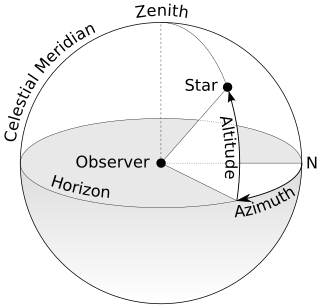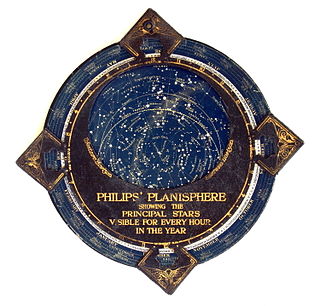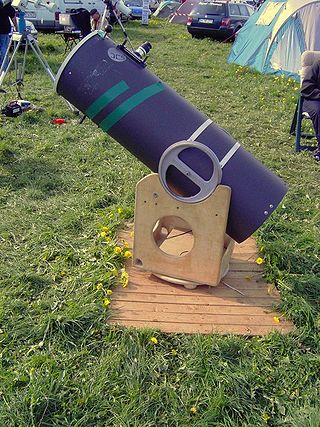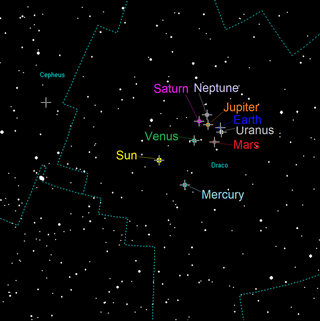This article needs additional citations for verification .(May 2022) |

Setting circles are used on telescopes equipped with an equatorial mount to find celestial objects by their equatorial coordinates, often used in star charts and ephemerides.
This article needs additional citations for verification .(May 2022) |

Setting circles are used on telescopes equipped with an equatorial mount to find celestial objects by their equatorial coordinates, often used in star charts and ephemerides.
Setting circles consist of two graduated disks attached to the axes – right ascension (RA) and declination (DEC) – of an equatorial mount. [1] The RA disk is graduated into hours, minutes, and seconds. The DEC disk is graduated into degrees, arcminutes, and arcseconds.
Since the RA coordinates are fixed onto the celestial sphere, the RA disk is usually driven by a clock mechanism in sync with sidereal time. Locating an object on the celestial sphere using setting circles is similar to finding a location on a terrestrial map using latitude and longitude. Sometimes the RA setting circle has two scales on it: one for the Northern Hemisphere and one for the Southern.
Historically setting circles have rivaled the telescopes optics as far as difficulty in construction. Making a set of setting circles required a lot of precision crafting on a dividing engine. Setting circles usually had a large diameter and when combined with a vernier scale could point a telescope to nearly an arc minute of accuracy. In the 20th century setting circles were replaced with electronic encoders on most research telescopes.
In amateur astronomy, setting up a portable telescope equipped with setting circles requires:
Accuracy of pointing the telescope can be hard to achieve. Some sources of error are:
It is common to blame an unlevel tripod as a source of error, however when a proper polar alignment is performed, any induced error is factored out.
These sources of error add up and cause the telescope to point far from the desired object. They are also hard to control; for example, Polaris is often used as the celestial north pole for alignment purposes, but it is over half a degree away from the true pole. Also, even the finest graduations on setting circles are usually more than a degree apart, which makes them difficult to read accurately, especially in the dark. Nothing can be done if the optical tube is not perpendicular to the declination axis or if the R.A. and Dec axes are not perpendicular, because these problems are next to impossible to fix.
In the southern hemisphere the Right Ascension scale operates in reverse from in the Northern Hemisphere. The term Right Ascension took its name from early northern hemisphere observers for whom "ascending stars" were on the east or right hand side. In the southern hemisphere the east is on the left when an equatorial mount is aligned on the south pole. Many Right Ascension setting circles therefore carry two sets of numbers, one showing the value if the telescope is aligned in the northern hemisphere, the other for the southern.
Even with some inaccuracies in polar alignment or the perpendicularity of the mount, setting circles can be used to roughly get to a desired object's coordinates, where a star chart can be used to apply the necessary correction. Alternatively, it is possible to point to a bright star very close to the object, rotate the circles to match the star's coordinates, and then point to the desired object's coordinates. Setting circles are also used in a modified version of star hopping where the observer points the telescope at a known object and then moves it a set distance in RA or declination to the location of a desired object.
Digital setting circles (DSC) consist of two rotary encoders on both axis of the telescope mount and a digital readout. They give a highly accurate readout of where the telescope is pointed and their lit display makes them easier to read in the dark. They have also been combined with microcomputers to give the observer a large database of celestial objects and even guide the observer in correctly pointing their telescope.
In contrast to a GOTO telescope mount, a mount equipped with DSC alone is sometimes called a "PUSH TO" mount.

In astronomy, declination is one of the two angles that locate a point on the celestial sphere in the equatorial coordinate system, the other being hour angle. Declination's angle is measured north or south of the celestial equator, along the hour circle passing through the point in question.

Right ascension is the angular distance of a particular point measured eastward along the celestial equator from the Sun at the March equinox to the point in question above the earth. When paired with declination, these astronomical coordinates specify the location of a point on the celestial sphere in the equatorial coordinate system.

In astronomy and navigation, the celestial sphere is an abstract sphere that has an arbitrarily large radius and is concentric to Earth. All objects in the sky can be conceived as being projected upon the inner surface of the celestial sphere, which may be centered on Earth or the observer. If centered on the observer, half of the sphere would resemble a hemispherical screen over the observing location.

Astronomicalcoordinate systems are organized arrangements for specifying positions of satellites, planets, stars, galaxies, and other celestial objects relative to physical reference points available to a situated observer. Coordinate systems in astronomy can specify an object's position in three-dimensional space or plot merely its direction on a celestial sphere, if the object's distance is unknown or trivial.

The equatorial coordinate system is a celestial coordinate system widely used to specify the positions of celestial objects. It may be implemented in spherical or rectangular coordinates, both defined by an origin at the centre of Earth, a fundamental plane consisting of the projection of Earth's equator onto the celestial sphere, a primary direction towards the vernal equinox, and a right-handed convention.

The horizontal coordinate system is a celestial coordinate system that uses the observer's local horizon as the fundamental plane to define two angles: altitude and azimuth. Therefore, the horizontal coordinate system is sometimes called the az/el system, the alt/az system, or the alt-azimuth system, among others. In an altazimuth mount of a telescope, the instrument's two axes follow altitude and azimuth.
Diurnal motion is an astronomical term referring to the apparent motion of celestial objects around Earth, or more precisely around the two celestial poles, over the course of one day. It is caused by Earth's rotation around its axis, so almost every star appears to follow a circular arc path, called the diurnal circle, often depicted in star trail photography.
In observational astronomy, culmination is the passage of a celestial object across the observer's local meridian. These events were also known as meridian transits, used in timekeeping and navigation, and measured precisely using a transit telescope.

In astronomy, a planisphere is a star chart analog computing instrument in the form of two adjustable disks that rotate on a common pivot. It can be adjusted to display the visible stars for any time and date. It is an instrument to assist in learning how to recognize stars and constellations. The astrolabe, an instrument that has its origins in Hellenistic astronomy, is a predecessor of the modern planisphere. The term planisphere contrasts with armillary sphere, where the celestial sphere is represented by a three-dimensional framework of rings.

In astronomy, the meridian is the great circle passing through the celestial poles, as well as the zenith and nadir of an observer's location. Consequently, it contains also the north and south points on the horizon, and it is perpendicular to the celestial equator and horizon. Meridians, celestial and geographical, are determined by the pencil of planes passing through the Earth's rotation axis. For a location not at a geographical pole, there is a unique meridian plane in this axial-pencil through that location. The intersection of this plane with Earth's surface is the geographical meridian, and the intersection of the plane with the celestial sphere is the celestial meridian for that location and time.
Star hopping is a technique that amateur astronomers often use to locate astronomical objects in the night sky. It can be used instead of or in addition to setting circles or go-to/push-to systems.

An altazimuth mount or alt-azimuth mount is a simple two-axis mount for supporting and rotating an instrument about two perpendicular axes – one vertical and the other horizontal. Rotation about the vertical axis varies the azimuth of the pointing direction of the instrument. Rotation about the horizontal axis varies the altitude angle of the pointing direction.

An equatorial mount is a mount for instruments that compensates for Earth's rotation by having one rotational axis, called polar axis, parallel to the Earth's axis of rotation. This type of mount is used for astronomical telescopes and cameras. The advantage of an equatorial mount lies in its ability to allow the instrument attached to it to stay fixed on any celestial object with diurnal motion by driving one axis at a constant speed. Such an arrangement is called a sidereal drive or clock drive. Equatorial mounts achieve this by aligning their rotational axis with the Earth, a process known as polar alignment.
A polar mount is a movable mount for satellite dishes that allows the dish to be pointed at many geostationary satellites by slewing around one axis. It works by having its slewing axis parallel, or almost parallel, to the Earth's polar axis so that the attached dish can follow, approximately, the geostationary orbit, which lies in the plane of the Earth's equator.

The meridian circle is an instrument for timing of the passage of stars across the local meridian, an event known as a culmination, while at the same time measuring their angular distance from the nadir. These are special purpose telescopes mounted so as to allow pointing only in the meridian, the great circle through the north point of the horizon, the north celestial pole, the zenith, the south point of the horizon, the south celestial pole, and the nadir. Meridian telescopes rely on the rotation of the sky to bring objects into their field of view and are mounted on a fixed, horizontal, east–west axis.

An orbital pole is either point at the ends of the orbital normal, an imaginary line segment that runs through a focus of an orbit and is perpendicular to the orbital plane. Projected onto the celestial sphere, orbital poles are similar in concept to celestial poles, but are based on the body's orbit instead of its equator.

In amateur astronomy, "GoTo" refers to a type of telescope mount and related software that can automatically point a telescope at astronomical objects that the user selects. Both axes of a GoTo mount are driven by a motor and controlled by a computer. It may be either a microprocessor-based integrated controller or an external personal computer. This differs from the single-axis semi-automated tracking of a traditional clock-drive equatorial mount.
Polar alignment is the act of aligning the rotational axis of a telescope's equatorial mount or a sundial's gnomon with a celestial pole to parallel Earth's axis.
In spherical astronomy, the parallactic angle is the angle between the great circle through a celestial object and the zenith, and the hour circle of the object. It is usually denoted q. In the triangle zenith—object—celestial pole, the parallactic angle will be the position angle of the zenith at the celestial object. Despite its name, this angle is unrelated with parallax. The parallactic angle is zero or 180° when the object crosses the meridian.

In astronomy, a clock drive is a motor-controlled mechanism used to move an equatorial mounted telescope along one axis to keep the aim in exact sync with the apparent motion of the fixed stars on the celestial sphere.